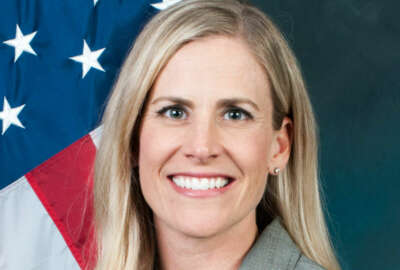NAVSUP can teach a thing or two about small business Defense procurements
The Naval Supply Systems Command keeps machinery and people equipped and ready to go. It has some award winning programs for ensuring small business participati...
Best listening experience is on Chrome, Firefox or Safari. Subscribe to Federal Drive’s daily audio interviews on Apple Podcasts or PodcastOne.
The Naval Supply Systems Command keeps machinery and people equipped and ready to go. It has some award winning programs for ensuring small business participation in its procurements. At the recent Sea Air Space Conference, the Federal Drive with Tom Temin caught up with NAVSUP’s Director of Small Business Chris Espenshade.
Interview transcript:
Tom Temin: You have done some real innovation in bringing small business that the supply systems command maybe tell us the range of things you supply, where DLA leaves off, and you take over that kind of thing. Like, what’s your space?
Chris Espenshade: Yeah, what makes us really unique is a Navy Supply System specifically for weapons systems support. So of course, what we call class 9 material, where we’re supporting the fleet’s need for any asset that’s turned in or a new production. So that’s best way to differentiate us with DLA. They’re more specifically on the consumable side, of course, they have petroleum as well, but think of us as the last technical mile, and an integration of logistics and sustainment for the Navy.
Tom Temin: And has that produced any of the issues that other areas of the economy have had with supply chain and so forth?
Chris Espenshade: Yeah, I mean, that’s one thing we talked about a lot is consolidation across the DoD space has been the last 30 years of major system support from defense contractors. But more specifically, when we look at what impacts we’ve had from sequestration, and kind of limiting the budget from the fleet, and what that does to weapon systems support. So as that demand signal dries up, a lot of our traditional vendors are exiting that market. That’s one of the great opportunities for small business to pick up is that niche of hey, in the last phase of sustainment of a weapon system cycle, we have a lot of opportunity for folks to manufacture or repair and overhaul some of these assets. So that’s what we’ve really been focusing on from a strategic standpoint, within NAVSUP.
Tom Temin: So you’re looking for small businesses to supply both services and manufactured items.
Chris Espenshade: Yeah, so there’s obviously a reseller opportunity there. But there’s also the opportunity to become an approved source through what we call hardware systems command. So we support the end items for NAVSEA, NAVAIR. So we work really closely with our engineering departments to approve these additional sources of supply. And what we’ve done last year, and this year is put out a source development opportunity list. So we’ve put out what we call 2,900 national stock numbers of saying, hey, we either only have one source of supply, or we want to do some additional source development there to get a broader marketplace, you know, proof competition numbers as well as opportunity to support increased capacity if needed. So we have that opportunity listing for manufacturers and for repair overhaul capability. We have that out on sam.gov.
Tom Temin: A couple of questions there, first of say, a weapon system support, how many of the support items are actually themselves commercial? I mean, the whole system is not a commercial system. But are there when you mentioned resellers? Are there parts that are standard that are put into these things? Nuts and bolts, that type of stuff?
Chris Espenshade: Yeah, so typically the sub-components, sub-assemblies, those sorts of things. And it really, it really depends on how in the front half how we provision these items. So if it’s down to the sub-component assembly, and we can quickly swap out, you know, cots type of material, that’s some of the challenges we see on the IT space is microelectronics, let’s say we have a failure of a sub-component assembly, but because it hasn’t been provisioned and down that low, we have to go after the entire assembly versus just that piece.
Tom Temin: Right. OK, so these 2900 commodities that are out there, and you mentioned, they’re on sam.gov, to develop new sources, they have to know about sam.gov and be able to navigate that whole system with their unique identifier and so on.
Chris Espenshade: Yeah, absolutely. Of course, if you’re interested in the federal marketplace, you have to understand what sam.gov is. And that’s the availability of opportunities across the federal marketplace. So you can quickly filter and narrow down specifically to Navy, and NAVSUP, if need be. But we also have within the NAVSUP business opportunities webpage, we have the last six years of our procurement data available that they can come take a look at, as well as they can pull it off of sam.gov and see across the federal marketplace and filter down strategically. Let’s see who buys what I sell?
Tom Temin: Sure we’re speaking with Chris Espenshade. He’s director of small business at the Naval Supply Systems Command. And what are some of the other innovations, you’re known for innovation of small business and everybody’s looking to get more in and more businesses and more business to them?
Chris Espenshade: Yeah, we were fortunate to be selected last year for the FY 21 Secretariat scope. So again, that’s the lead small business office across the Navy. And a lot of that was resulting of how we’re utilizing DoD’s mentor protege program, in which we pair a traditional manufacturer or OEM with a small business. And what we’ve done with that program is we’ve reached out to folks that traditionally support these weapon systems. We said, hey, for the business that you’re transitioning out of, let’s match up with a small business and help them fill that void and bridge that gap when they exit the marketplace. And it’s a great opportunity for small business to be a niche.
Tom Temin: And your measures are percentage of dollars for small business, but also the number and types of small businesses that participate.
Chris Espenshade: Yeah. So traditionally how the SBA kind of grades, all the agencies is we have five major categories: small business, small disadvantaged business, service disabled, veteran owned, woman owned, and then HUBZone categories. And that’s percentage of total dollar value. But what we also do at NAVSUP, is we look at what we call the small business effectiveness rate. And that’s how many of each action went to small business, not just percentage of total dollar value. So that quickly means that each individual action is very important to us in terms of advocating for small business.
Tom Temin: And is 2023 looking up for you do you think?
Chris Espenshade: Last year we had a record year for obligations to small business across almost all categories. In FY 22 are probably a little bit behind. You know, a lot of that is budget impacts. But in terms of small business impact and our ability right now, we’re trending better than we were last year and overall.
Tom Temin: Chris Espenshade is director of small business at the Naval Supply Systems Command.
Copyright © 2024 Federal News Network. All rights reserved. This website is not intended for users located within the European Economic Area.
Tom Temin is host of the Federal Drive and has been providing insight on federal technology and management issues for more than 30 years.
Follow @tteminWFED






